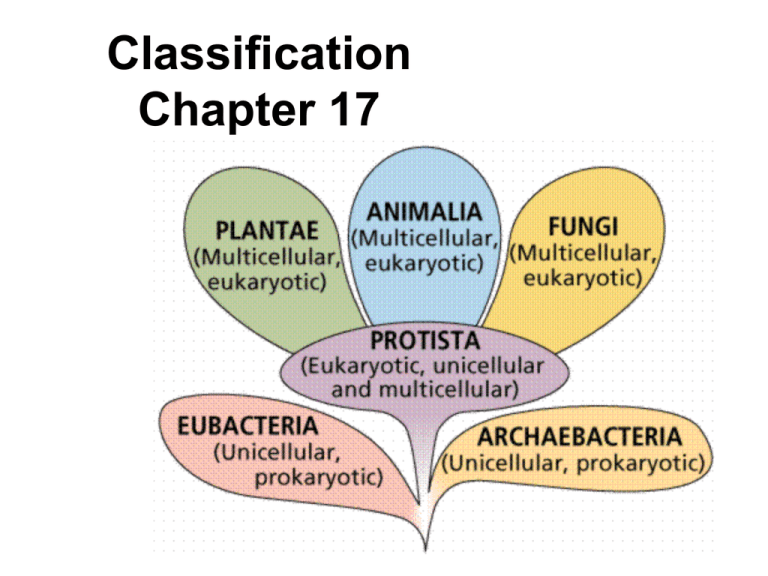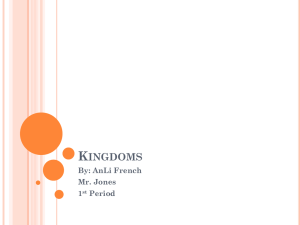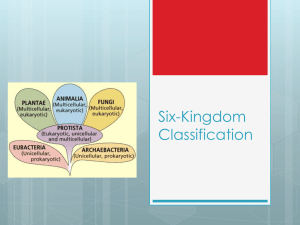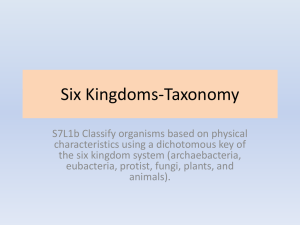Organism Classification: Taxonomy & Kingdoms Presentation
advertisement

Classification Chapter 17 Why classify organisms? currently there are 1.5 million known species of living things Taxonomy field of science that deals with classifying organisms according to their characteristics and evolutionary history Early Classification Aristotle – 2000 BC devised a classification system • divided living things into 2 groups PLANTS – divided into smaller groups based on their stem structure – herbs, shrubs, trees ANIMALS – divided into smaller groups based on their habitat – land, air, water Early Classification Linnaeus - 1700’s - naturalist • devised a classification system based on comparative morphology • classification system had 7 taxonomic categories (called TAXONS) • devised a way to give each organism a unique 2 word name 7 taxonomic categories • • • • • • • Kingdom – largest group; most variety Phylum/Division Class Order Family Genus Species – smallest group; least variety ACRONYM • • • • • • • kingdom - KING phylum - PHILLIP class - CAME order - OVER family - FROM genus - GREAT species - SPAIN American Crow • • • • • • • Kingdom: Animalia Phylum: Chordata (with backbones) Class: Aves (birds) Order: Passeriformes (songbirds) Family: Corvidae (crows, jays) Genus: Corvus Species: brachyrhynchos What do these animals have in common? Why classify bats and birds together but not include dragonflies? Answer this…. Would a horse and a zebra belong to the same species? Why or why not? Might they be members of the same genus? Why or why not? Would a dog and a wolf belong to the same species? Why or why not? Might they be members of the same genus? Why or why not? Binomial Nomenclature • giving an organism a 2 word name, A SCIENTIFIC NAME consists of two words Genus – 1st word – capitalized species – 2nd word – lower case *written in latin *underlined or italicized Why Latin? • “dead” language – no changes being made – it is not in use today • is the basis for many of today’s languages • assures a unique name for each species Names may tell you… • Name of geographic location • Who discovered it • The look of the organism • Example: – Linnea borealis – Odocoileus virginianus – Felis domesticus Lasionycteris noctivagans • nocti = nocturnal • vagans = wanderer • nyct = night “wanderer at night” Silver-haired bat Dichotomous Key “dividing into two parts” • used to help identify an organism based on it characteristics • at each step in a dichotomous key you have 2 choices Species • Typological: based on physical characteristics (not used anymore) • Biological: based on the ability to breed and produce fertile offspring • Phylogenetic: based on evolutionary relationships (evolving from a common ancestor) MODERN CLASSIFICATION Today, taxonomists classify organisms in such a way as to indicate evolutionary relationships. Archaeopteryx – believed to be the ancestor of birds Modern Taxonomy IS NOT BASED ON HABITAT!!!! Today, taxonomists use… • comparative morphology • fossil evidence • embryological evidence • chromosomal evidence • biochemical similarities • physiological similarities • evolutionary relationships to determine the classification of an organism Other Changes… sometimes, more than 7 categories are needed…. SUBCATEGORIES CAN BE USED… subkingdom subphylum subclass suborder subfamily subgenus subspecies DERIVED CHARACTERS are used to help determine evolutionary relationships Derived Character - a feature (trait) that apparently evolved only within a specific groups of organisms such as - jaws, lungs, claws, feathers, mammary glands,…. Ancestral Character – found with the entire line of descent (including the ancestor) Cladogram diagram made by cladistic analysis that shows the evolutionary relationships of organisms 2 Modern Systems of Classification 3 domain system Domain archaea Domain bacteria Domain eukarya 6 kingdom system Kingdom archaebacteria Kingdom eubacteria Kingdom protista Kingdom fungi Kingdom plantae Kingdom animalia Differences among Kingdoms Archaebacteria and Eubacteria: prokaryotic, unicellular Protista: eukaryotic, unicellular and multicellular Fungi: eukaryotic, cell wall of chitin, no chloroplasts, unicellular and multicellular, heterotrophic Plantae: eukaryotic, cell wall of cellulose, chloroplasts, all multicellular, autotrophic Animalia: eukaryotic, no cell wall, all multicellular, heterotrophic Kingdoms Archaebacteria and Eubacteria (previously classified together as kingdom Monera) Bacteria…. Eubacteria and Archaebacteria • • • • many are saprophytic (feed on dead organic matter) many are parasitic (feed on living organic matter) among the first forms of life prokaryotic ONLY KINGDOMS lacking an organized nucleus and membrane-bound organelles Nostoc (cyanobacterium) Methods of energy acquisition • Chemosynthesis • photosynthesis • heterotrophic Kingdom Archaebacteria (“old bacteria”) • • • • • prokaryotic cell wall does not contain peptidoglycan have unusual lipids in cell membrane oldest and most primitive organisms known life’s extremists - occupy environments that “normal” organisms find too harsh Archaebacteria….3 groups…. Methanogens - produce methane gas, found in soil, swamps, digestive tracts of animals Extreme Halophiles – live in high salt environments, found in salt lakes, Dead Sea Thermoacidophiles – live in hot, acidic environments, found in volcanic vents, hydrothermal vents Kingdom Eubacteria (“true bacteria”) • cell wall contains peptidoglycan • includes most of the bacteria that affects our daily life including…. tetanus, strep throat, tooth decay, E. coli, salmonella, botulism, lyme disease, syphilis, and many more…. • some capable of chemosynthesis, some photosynthesis, others are heterotrophic Bacteria – Roles in Ecosystem • can cause disease • photosynthesis and oxygen production – cyanobacteria (“blue-green bacteria”) contributed to formation of atmospheric oxygen by photosynthesis • food source • nutrient transfer – convert atmospheric N into forms useable forms for plants and animals • decomposition – saprophytic (decompose dead tissue) – symbiotic (live within a host organism) • some oil deposits are attributed to cyanobacteria Kingdom Protista algae, protozoa, fungus-like protists Protista • Animal-like (protozoan), plant-like (algae) and fungus-like protists • heterotrophic and autotrophic • eukaryotic • freshwater, saltwater, soil • because of great diversity, classification is difficult paramecium Eukaryotes that are NOT fungi, animals, or plants! Protista…. 3 groups…. Protozoa (“first animal”) – “animal like”, single-celled, motile, heterotrophic – digest food by engulfing, digesting, and absorbing it Algae – “plant like”, single-celled or colonial or multicellular – diatoms, algae, dinoflagellates,… Fungus Like Protists - “fungus like”, includes slime molds and others http://www.emc.maricopa.edu/faculty/farabee/BIOBK/BioBookDiversity_3.html Protista – Roles in Ecosystem • photosynthesis and oxygen production • food source (algae) – animal feed, fertilizers – algae sheets used in some Japanese dishes – additive to puddings, ice cream, salad dressing, candy (carrageenan and alginate) • can cause disease – avian malaria, human malaria, amoebic dysentery Protista and Red Tides http://www.redtide.whoi.edu/hab/rtphotos/noctiluca.jpg • population explosion of dinoflagellates • neurotoxin released • shellfish concentrate toxin • humans can be killed by eating shellfish contaminated by toxin Kingdom Fungi mushrooms, blights, rusts, molds, puffballs, morels, yeasts, truffles, toadstools, shelf fungi,…. Fungi • • • • • • • • • • eukaryotic made up of hyphae mycelium=mass of hyphae no roots, stems or leaves no chlorophyll saprophytic or parasitic reproduce by spores cell walls contain chitin absorptive heterotrophs multicellular and unicellular species Roles in Ecosystem • Food Source – mushrooms, truffles, morels, cheeses, bread, beer and wine • Production of some Antibiotics • Crop Parasites – cause loss of food plants, spoilage, infectious disease • Dutch Elm Disease • Chestnut Blight • Benefit Wildlife – food source, nest sites, hiding places and cover • Symbiosis - Mutualism – lichens (fungus + alga) – mycorrhizae (fungus and plant roots) Kingdom Plantae Plants • eukaryotic, multicellular, photoautotrophs • cell wall with cellulose 2 major groups of plants nonvascular and vascular Nonvascular Plants • small (lack conducting cells) • likely were the earliest land plants • liverworts, hornworts and mosses Vascular Plants • have specialized cells for transporting materials • Xylem (for transporting water and mineral nutrients) • Phloem (for transporting sugars from leaves to the rest of the plant) • pines, cacti, grasses, trees, flowers, ….. Plants – Roles in Ecosystem • food source • generate oxygen • provide habitat for humans and wildlife American chestnut, late 1800s Kingdom Animalia •multicellular •heterotrophic •eukaryotic •no cell wall 2 main groups invertebrates and vertebrates Invertebrates (animals without a backbone) sponges, jellyfish, corals, sea anemones, scallops, oysters, snails, octopi, squid, sea urchins, sea stars, spiders, scorpions, crabs, shrimp, insects, worms, rotifers, comb jellies,… Vertebrates animals with a backbone (of bone or cartilage) fish, amphibians, reptiles, birds, mammals Let’s Review This characteristic separates which kingdoms…. • All members are heterotropic? • All members are autotrophic? • Contains both heterotrophic and autotrophic members? • All members prokaryotic? • All members eukaryotic? • Have chloroplasts? • Have a cell wall? • All members unicellular? • All members multicellular? • Contains both unicellular and multicellular members?









